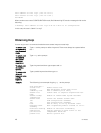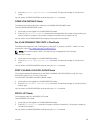
2. Enter the ip dhcp server command. The prompt changes to include (config-dhcp).
You can return to CONFIGURATION mode by using the exit command.
DHCP POOL Mode
To create an address pool, use DHCP POOL mode. For more information, refer to Dynamic Host
Configuration Protocol (DHCP).
To enter DHCP POOL mode:
1. Verify that you are logged in to DHCP mode.
2. Enter the pool command then the pool name. The prompt changes to include (config-dhcp-pool-
name).
You can return to DHCP mode by using the exit command.
ECMP GROUP Mode
To enable or configure traffic distribution monitoring on an ECMP link bundle, use ECMP GROUP mode.
For more information, refer to ecmp_overview.
To enter ECMP GROUP mode:
1. Verify that you are logged in to CONFIGURATION mode.
2. Enter the ecmp-group command then enter the ECMP group ID. The prompt changes to include
(conf-ecmp-group-ecmp-group-id).
You can return to CONFIGURATION mode by using the exit command.
EIS Mode
To enable or configure Egress Interface Selection (EIS), use EIS mode.
To enter EIS mode:
1. Verify that you are logged in to CONFIGURATION mode.
2. Enter the management egress-interface-selection command. The prompt changes to
include (conf-mgmt-eis).
You can return to CONFIGURATION mode by using the exit command.
EXEC Mode
When you initially log in to the switch, by default, you are logged in to EXEC mode. This mode allows you
to view settings and enter EXEC Privilege mode, which is used to configure the device.
When you are in EXEC mode, the > prompt is displayed following the host name prompt, which is “Dell”
by default. You can change the host name prompt using the hostname command.
NOTE: Each mode prompt is preceded by the host name.
EXEC Privilege Mode
The enable command accesses EXEC Privilege mode. If an administrator has configured an “Enable”
password, you are prompted to enter it.
EXEC Privilege mode allows you to access all the commands accessible in EXEC mode, plus other
commands, such as to clear address resolution protocol (ARP) entries and IP addresses. In addition, you
CLI Basics
55


















